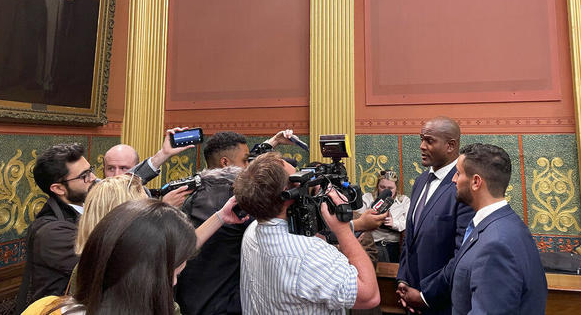
Midterm elections shake up state legislatures
 Two years ago, control of only one state legislature flipped from one party to another. This year saw more changes, some of them surprising and some less so.
Two years ago, control of only one state legislature flipped from one party to another. This year saw more changes, some of them surprising and some less so.
Redistricting, of course, was behind some of these changes. In Michigan, an independent redistricting commission redrew all the legislative district boundaries, and a subsequent high-turnout election wound up flipping both chambers to Democratic control, for the first time in 40 years. With the re-election of Gov. Gretchen Whitmer as well, Democrats now enjoy a political “trifecta” in Michigan.
In separate caucuses Thursday, Democratic lawmakers selected Rep. Joe Tate as speaker of the House and Minority Whip Winnie Brinks as Senate president.
Democrats also won a trifecta in Minnesota Tuesday by flipping the state Senate. As in Michigan, where turnout was driven by push to enshrine abortion rights in the state constitution, the same issue was credited with changing the Minnesota political map.
By contrast, Florida voters elected more Republican legislators, boosting that party’s clout by creating supermajorities in both chambers, and increasing the likelihood that that state will enact even tougher anti-abortion restrictions. New York’s legislature also shifted to the right this week, after courts blocked the Democratic-controlled legislature from redrawing districts to its advantage. Depending on the outcome of two especially tight contests in Brooklyn and Syracuse, Democrats could lose supermajority status in the Senate, but will still maintain trifecta control of state government.
Vermont’s Democratic/Progressive coalition kept a 23-seat supermajority in the Senate and gained a supermajority in the House, giving it the ability to override Republican Gov. Phil Scott’s vetoes. There the Democrats’ 104-member House delegation will be its largest ever.
In New Hampshire, where Republicans flipped both chambers in 2020, they appear to have held a majority in the 400-member House, pending recounts, but the 26-seat edge they had entering the 2021-22 session is now narrowed to 6.
An especially surprising flip may be brewing in the Pennsylvania House. Although Republicans entered the election with a 113-90 edge, Democrats have all but erased that gap. For now they hold narrow leads in three undecided races in the Philadelphia suburbs – in one case by just 2 votes. If they win these they may eventually control the House by one or two seats.
But not right away. Special elections need to be held first in two districts: one where the incumbent was elected to Congress and another where voters this week re-elected a man who died in October. House Republicans may delay those elections for a few months to prolong their stay in power.
As in Michigan and Minnesota, similar factors contributed to the big turnaround in Pennsylvania. The election featured extremely high-profile Senate and gubernatorial races, and Democrats benefited from favorable legislative redistricting. Also, a Democratic-controlled House would block Senate Republican from adding an anti-abortion provision to the state constitution.
The Senate, where only half the seats were up for grabs, is projected to remain under Republican control.
Out west, the jury is still out in Arizona. Ballots are still being counted, but so far the Republican advantage in both chambers has been whittled down to 1 seat each. In Nevada, where Republican Joe Lombardo still leads in the race for governor, Democrats are projected to keep control of both chambers, but fall short of veto-proof supermajorities.
In Alaska, which uses ranked-choice voting, Democrats appear to be on track to win 9 seats in the Senate. While not a majority, it has inspired back-room negotiations with 3 Republican moderates to form a bipartisan coalition to control that chamber. Meanwhile, Republicans are leading 21 of 40 House districts, but results could flip in four races once mail-in ballots are counted and ranked-choice results are tallied.
Oregon Republicans entered this cycle with a realistic hope not only of cracking a Democratic trifecta, but winning one of their own. But Democrat Tina Kotek won a tight gubernatorial race, and the GOP appears to have made only modest gains in legislative races.
Altogether, many of these shifts around the nation favored Democrats – catching many observers by surprise, since it is unusual for the party in power in Washington to make any gains in midterm elections.
Republicans fared better judicial elections in those states that choose judges that way. In Ohio, three conservatives were elected to the State Supreme Court, and Gov. Mike DeWine will appoint another to a vacant seat, creating a Republican majority. Republican voters also installed a new conservative majority on the North Carolina State Supreme Court, which lately has thwarted legislative attempts to draw districts favoring Republicans.

